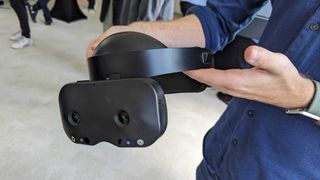I can't stop thinking about this unique VR headset design
The Lynx-R1 and Almer XR gadgets made an impression

I recently had the chance to check out some awesome new XR hardware and software that's powered by Qualcomm tech, and I can’t stop thinking about two of the wonderfully strange headsets that I got to try.
The first is the Lynx-R1 mixed-reality headset. To be a little reductive, it’s a lot like the Meta Quest Pro in terms of its design and capabilities. It’s powered by a Snapdragon XR2 Gen 1 chipset, boasts six cameras for tracking your position, hands, and full-color passthrough, and offers users the chance to enjoy both virtual and mixed reality experiences. As with the Quest Pro, the battery serves as a counterweight to the front screen panel to help with comfort, and the screen doesn’t have light blockers by default – this means you can always see the real world to the left, right, and below the display which I find is great for mixed reality but can be distracting in virtual reality.
Where things get really interesting, however, is that the screen doesn’t always have to be in front of you – you can flip it up when you need to have an unobscured view, then fold it back down when you’re ready to be immersed again.


While we’d all like to be able to enjoy VR uninterrupted, it’s not always possible to stay immersed for hours on end. Be it the sound of a door opening and someone coming into your room, the clatter of some hard object tumbling to the floor after you knocked it over, or accidentally walking into a pet that’s made your play space its nap zone, there are a whole host of reasons why you might want to be able to see the real world quickly. As mixed reality becomes more prevalent, many headsets include options to swiftly turn on full passthrough, but instinctively I always go to rip the headset off my face – and then complain to myself when it stays attached because I’ve forgotten to loosen the straps. It’s then a fuss to put the headset back on, get it comfy again, and return to the VR world.
The Lynx-R1 takes away this hassle. When I need full vision I can flip the screen up, and then when I’m done I just fold the screen back down and pick up from where I left off.
The Lynx-R1’s screen isn’t yet perfect, mind. While on paper the 90-degree field of view is larger than that of the Oculus Quest 2 (which is only 89 degrees horizontally), I found that VR experiences felt more cramped than on other headsets. The overall headset also looks very industrial – though that’s likely because it only exists as an enterprise gadget, rather than one aimed at regular folks.
I’m excited to see what the team works on next, though. With a consumer-friendly headset apparently on the way sometime in the near future I hope it keeps the folding screen. It could really help to make VR feel more accessible for folks who own lots of pets, need to look after family, or just hate the sense of isolation VR can bring and need to check in on reality every so often.
Get daily insight, inspiration and deals in your inbox
Sign up for breaking news, reviews, opinion, top tech deals, and more.
Tech support you can wear

The other XR gadget was Almer, an AR eye-piece that is worn like a head torch. Using the single massive camera in the middle of the Almer device’s headband someone can see the world as you do, and they can then send you information via the eyepiece that juts down into your right eye’s vision. In the demo, I was shown how a person can remotely talk me through a problem that's in front of me in the real world and can even annotate still images of my view to highlight key objects.
Just like the Lynx-R1 this is a gadget aimed at business uses for now, but the Almer team is interested in bringing something similar to regular consumers. Just think - the next time you have a technical issue, rather than trying to translate the problem to support over the phone or via a text chat, you can show them a live feed of what’s happening. By following their instructions, you may be able to solve the issue without ever having to send your faulty item away for repair or wait for a technician to visit your home. Wouldn’t that be great?
While there’s no telling when versions of these headsets will be made available for consumers, we don’t have long to wait to see new consumer XR tech. Meta Connect 2023 is coming soon, on September 27, and there we should learn more about the Meta Quest 3 as well as anything else XR- and AI-related that Meta has been working on.
You might also like

Hamish is a Senior Staff Writer for TechRadar and you’ll see his name appearing on articles across nearly every topic on the site from smart home deals to speaker reviews to graphics card news and everything in between. He uses his broad range of knowledge to help explain the latest gadgets and if they’re a must-buy or a fad fueled by hype. Though his specialty is writing about everything going on in the world of virtual reality and augmented reality.